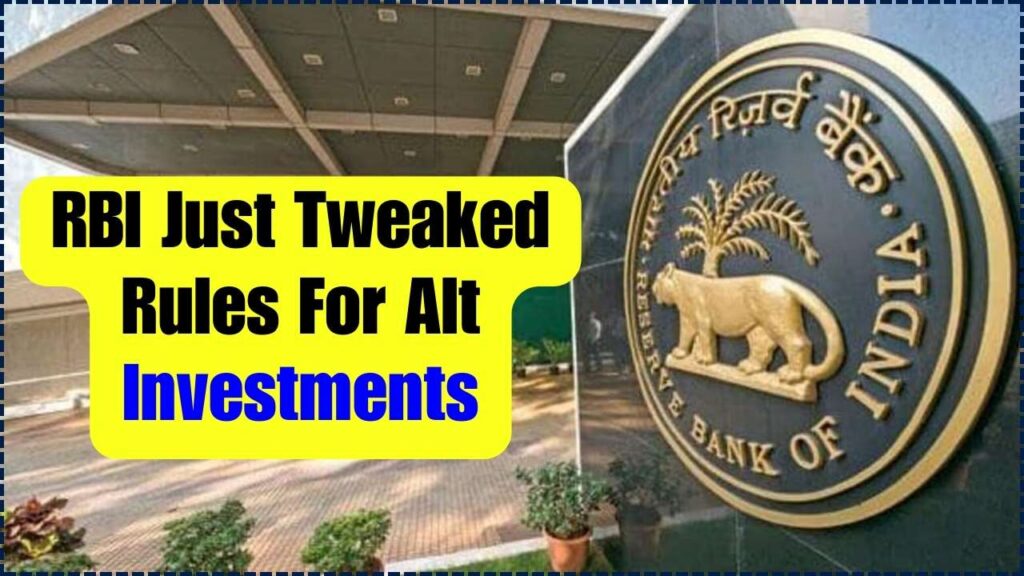RBI Just Tweaked Rules For Alt Investments: In a major regulatory update, the Reserve Bank of India (RBI) has proposed changes to the rules surrounding investments in Alternative Investment Funds (AIFs). These new guidelines, released in draft form, are designed to ensure financial prudence and transparency while promoting a balanced approach to risk in India’s alternative investment space.

If you’re an investor, fund manager, or finance professional, this move could impact how you engage with AIFs—an increasingly popular investment vehicle for high-net-worth individuals, institutions, and regulated entities. Let’s unpack what these changes mean and why they matter.
RBI Just Tweaked Rules For Alt Investments
| Aspect | Details |
|---|---|
| Regulatory Body | Reserve Bank of India (RBI) |
| Subject | Investment norms for Regulated Entities (REs) in Alternative Investment Funds (AIFs) |
| Investment Cap Per RE | 10% of a scheme’s corpus |
| Aggregate Cap for REs | 15% of the scheme’s corpus |
| Provisioning Requirement | 100% provisioning if RE’s exposure >5% and AIF lends to linked borrower |
| Exemptions | Strategic AIFs exempted upon government consultation |
| Application Timeline | Prospective only; current investments governed by existing rules |
| Public Comment Deadline | June 8, 2025 |
| Source | RBI Official Notification |
The RBI’s latest proposal to tweak rules for Alternative Investment Funds aims to strengthen investor protection, enhance transparency, and mitigate systemic risks. While these changes may introduce some operational adjustments, they also mark a progressive step toward more sustainable and responsible investing.
If you’re part of the growing ecosystem around AIFs—whether as an investor, manager, or advisor—now’s the time to review your portfolios, revisit your compliance strategies, and prepare for a more regulated future.
What Are AIFs and Why Do They Matter?
Alternative Investment Funds (AIFs) are privately pooled investment vehicles that collect money from sophisticated investors to invest in assets other than stocks, bonds, or cash. These include private equity, hedge funds, venture capital, infrastructure, and real estate investments.
AIFs are regulated by SEBI in India and categorized into three types:
- Category I: Invest in startups, SMEs, and socially relevant sectors.
- Category II: Private equity funds, debt funds, etc., with no leverage.
- Category III: Hedge funds, employing diverse strategies and leverage.
As of March 2024, the total AUM (Assets Under Management) in AIFs stood at over ₹10 lakh crore, making them a major player in the non-traditional investment landscape.
What’s Changing in the RBI’s Draft Rules As RBI Just Tweaked Rules For Alt Investments?
1. Investment Limits for Regulated Entities
Regulated entities (REs)—such as banks, NBFCs, and insurance companies—will now be limited to:
- 10% of the AIF scheme’s total corpus per RE
- A total of 15% from all REs combined
This prevents excessive exposure by financial institutions to any one AIF scheme, limiting systemic risk.
2. Provisioning Norms for Related Exposure
If a Regulated Entity:
- Invests more than 5% in an AIF scheme
- And the AIF lends (downstreams) to a borrower connected to that RE
Then the RE must make a 100% provision for that exposure. That means setting aside the entire amount as a buffer in case the borrower defaults.
This rule aims to stop indirect routing of funds back to borrowers already connected to the investing institution, thereby reducing potential conflict of interest.
3. Relaxation for Lower Exposure
If an RE’s investment in an AIF is 5% or less, no special provisioning rules will apply—even if the AIF lends to related borrowers. This offers flexibility to small investors without compromising regulatory safeguards.
4. Exemptions for Strategic AIFs
Certain AIFs, especially those established for national security, infrastructure development, or other strategic objectives, may be exempted from these rules. Such exemptions will be made in consultation with the Central Government.
This allows strategic investments to proceed smoothly without regulatory friction.
5. Prospective Application Only
These changes are not retroactive. Investments already made under the current framework will not be affected. The new rules will only apply to new investments made after the final regulations come into force.
Why the RBI Made These Changes
The RBI’s new draft rules come in response to:
- Concerns about round-tripping of funds (e.g., REs indirectly financing connected borrowers through AIFs)
- Risk concentration in specific AIFs
- Need for consistent provisioning norms
By putting clear caps and conflict-of-interest checks in place, the RBI is ensuring a more transparent, stable financial ecosystem without stifling innovation in the AIF market.
How This Affects You: Practical Scenarios
For Individual Investors:
These rules don’t apply directly to you, but if you’re investing through portfolio managers or funds affiliated with REs, the exposure limits could influence which AIFs are open to you.
For Financial Institutions:
You’ll need to evaluate your exposure carefully, track AIF investments linked to borrowers in your own books, and maintain 100% provisioning if applicable.
For Fund Managers:
If you manage an AIF, you’ll need to:
- Maintain disclosure transparency about your investors and downstream lending
- Avoid downstream debt exposure to borrowers linked to your RE investors, especially when their stake is above 5%
Expert Views
“These draft norms strike a balance between prudence and flexibility. They address potential loopholes without disrupting the capital flow into startups and infrastructure,” says Anuj Mehrotra, a financial regulatory consultant.
“Provisioning ensures risk accountability. It’s the RBI’s way of saying—invest if you must, but don’t expect a bailout if things go south,” adds Nisha Kamat, a compliance head at a leading NBFC.
RBI Just Tweaked Rules For Alt Investments What Investors Should Do Now
- Review Investment Channels: If you’re an institutional investor, identify any AIFs in your portfolio with exposure above 5% and check if they lend to borrowers connected to your entity.
- Understand Fund Composition: For fund managers and distributors: Map out your top investors, their RE status, and whether your fund has downstream debt links.
- Stay Updated on Final Guidelines: Submit feedback before the June 8, 2025 deadline. Once final rules are out, align your policies immediately.
- Reassess Risk Models: If provisioning is required, update your capital adequacy and provisioning books to avoid non-compliance later.
- Communicate Clearly with Stakeholders: Transparency builds trust. Make sure your clients, investors, and partners are aware of these changes and how your firm plans to comply.
FAQs On RBI Just Tweaked Rules For Alt Investments
Q1. What is a Regulated Entity (RE)?
Any institution under the regulatory oversight of RBI—such as banks, NBFCs, and financial intermediaries.
Q2. Do these rules apply to retail investors?
No. The new norms are applicable only to investments made by REs in AIFs.
Q3. What does provisioning mean?
It means setting aside a portion of capital to cover potential losses—essentially a financial buffer against bad loans or investments.
Q4. Will this affect fundraising by AIFs?
Possibly, especially from REs. But it might lead to a more diversified investor base and more careful downstream lending.
Q5. Can existing investments be affected?
No. The changes apply only to new investments made after the final regulations are implemented.






